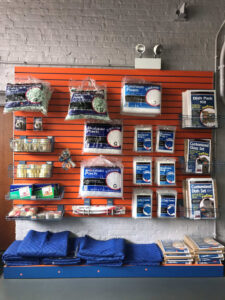How to Pack Fragile Items for Your Next Move!
Home » Latest Blogs: Midway Moving »Moving to a new home is exciting, but transporting your fragile heirlooms and delicate possessions can be nerve-wracking – one wrong bump and years of memories could be shattered. The good news is that with the right moving checklist and packing materials, you can greatly reduce the risk of damage. This guide will walk you through how to pack fragile items for moving and also how to unpack them safely once you arrive, ensuring your valuables stay intact throughout the move.
Gather Essential Packing Materials
Before you start, assemble all the necessary high-quality packing materials and supplies. Having the right materials on hand will make the process smoother and help protect your breakables. Key supplies include:
- Sturdy boxes in suitable sizes – Small or medium boxes work best for heavy fragile items like dishes or glassware. Overloading a large box can lead to breakage.
- Bubble wrap & packing paper – These materials cushion fragile items and prevent scratches.
- Packing peanuts or foam sheets – Perfect for filling empty spaces to stop shifting.
- Strong packing tape – Reinforce all seams for added security.
- Marker and labels – Clearly mark FRAGILE on multiple sides to ensure careful handling.
If you’re unsure where to get these supplies, Midway Moving offers quality packing supplies to help protect your fragile items.
Step-by-Step Guide to Packing Fragile Items
1. Line the Box with Cushioning
Start by placing a thick layer of padding (packing paper, bubble wrap, or a folded towel) at the bottom of the box. This creates a shock-absorbing base that helps prevent breakage.
2. Wrap Each Item Individually
Each fragile item should be wrapped separately to avoid direct contact. Use packing paper first, then wrap in bubble wrap for extra protection. Secure with tape.
3. Arrange Items Strategically
- Place heavier items at the bottom and lighter ones on top.
- Plates should be packed vertically rather than stacked flat.
- Fill empty spaces with packing peanuts or crumpled paper to prevent shifting.
4. Seal & Label the Box
- Use strong packing tape to reinforce the bottom and top seams.
- Clearly label the box as FRAGILE on all sides.
- Mark the box with “This Side Up” if necessary.
For extra protection, consider Midway’s Full-Service Packing, where professional packers handle everything for you.
Checklist for Packing Fragile Items
Here’s a quick checklist for packing fragile items properly:
✔ Gather packing supplies
✔ Line the box with cushioning
✔ Wrap each item individually
✔ Place items in the box strategically
✔ Fill gaps with packing peanuts or paper
✔ Seal the box securely with strong tape
✔ Clearly label the box as FRAGILE
This step-by-step method ensures that your delicate belongings arrive in perfect condition.
Common Packing Mistakes to Avoid
Avoid these common mistakes that can lead to damaged fragile items:
Overpacking large boxes – Makes them too heavy and difficult to carry.
Using weak or old boxes – Worn-out boxes may collapse under pressure.
Not labeling boxes as FRAGILE – Increases the risk of rough handling.
Neglecting to fill gaps – Items that shift during transit are more likely to break.
For extra peace of mind, let Midway’s expert packers handle your fragile items safely.
How to Unpack Fragile Items Safely
After the move, unpacking fragile items should be done carefully and strategically. Follow these tips:
✅ Place the box on a padded surface before opening.
✅ Cut the tape gently to avoid damaging items inside.
✅ Remove packing materials first, checking for any small pieces wrapped up.
✅ Unpack items one by one, placing them in their designated spots immediately.
Expert Tips for Moving Fragile Items Like a Pro
Want pro-level protection for your valuables? Here are some expert moving tips:
⭐ Use specialty boxes – Consider dish-pack boxes for glassware and china.
⭐ Wrap fragile items in moving blankets – Protects large mirrors, artwork, or furniture with glass.
⭐ Avoid using newspaper for wrapping – Ink can transfer and stain delicate surfaces.
⭐ Consider double-boxing valuables – Adds extra protection for expensive or irreplaceable items.
⭐ Secure insurance for high-value fragile items – Protects against unexpected damage.
If you’d rather have professionals pack your fragile belongings safely, Midway’s professional packing team can do it for you.
Should You Consider Professional Packing Services?
Packing fragile items takes time and patience. If you want 100% assurance that your delicate items are packed correctly, consider Midway’s Full-Service Packing.
Why choose professional packing?
✔ Midway’s trained movers use expert packing techniques
✔ They provide high-quality materials like dish packs & foam padding
✔ Your fragile items are insured & protected during transit
If you need help, check out our Full-Service Packing Options or contact us for a free quote.
Final Thoughts
By following the best practices outlined in this guide, you can protect your fragile items and ensure they arrive safely at your new home. Remember:
✔ Use high-quality packing materials
✔ Pack strategically and avoid common mistakes
✔ If needed, trust Midway’s professional packing services
Packing fragile items doesn’t have to be stressful—just take your time, plan ahead, and follow these steps. Happy moving!

